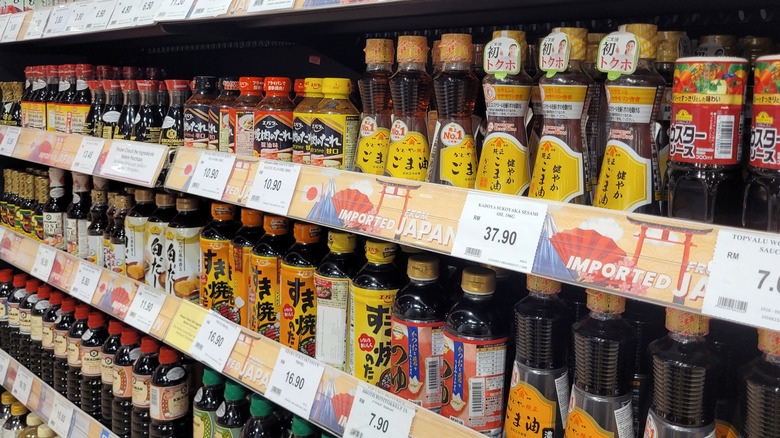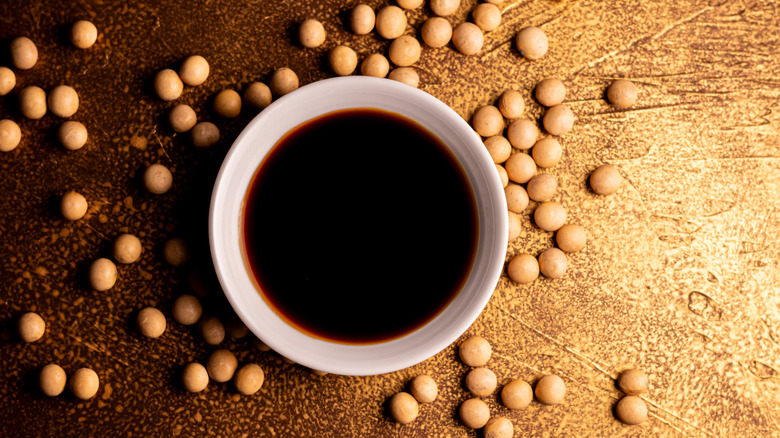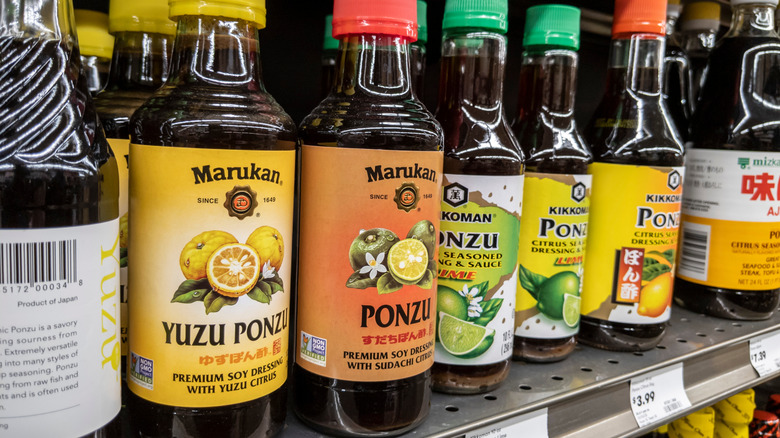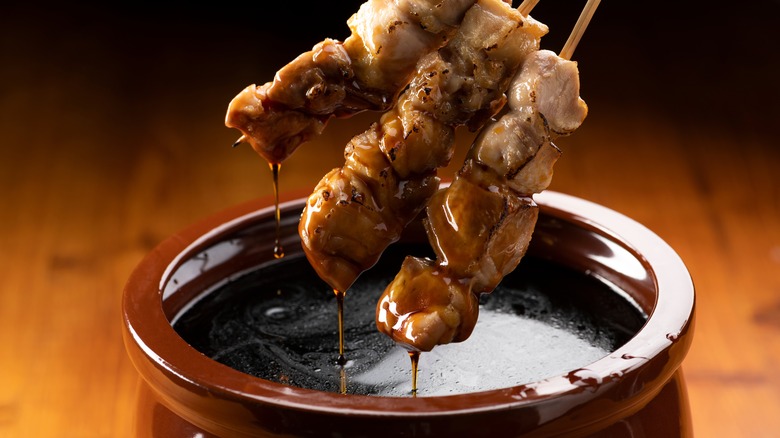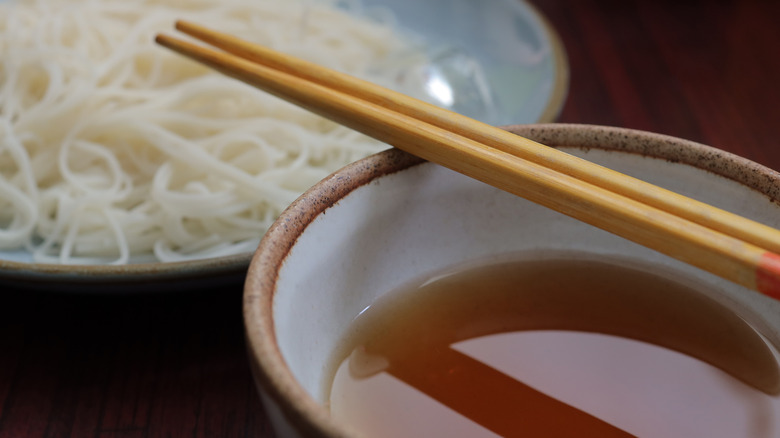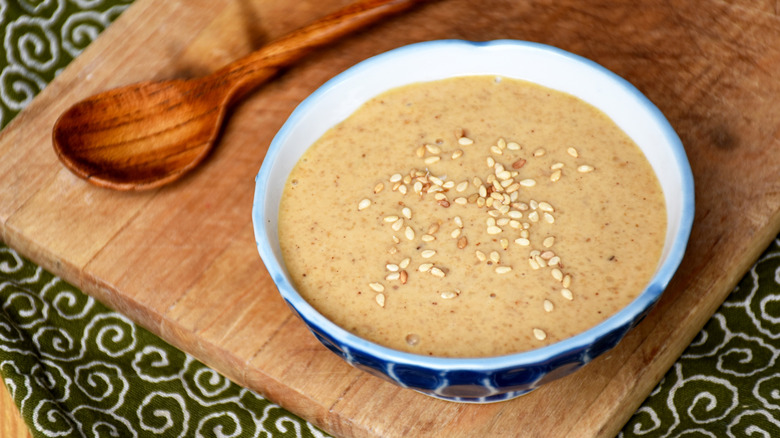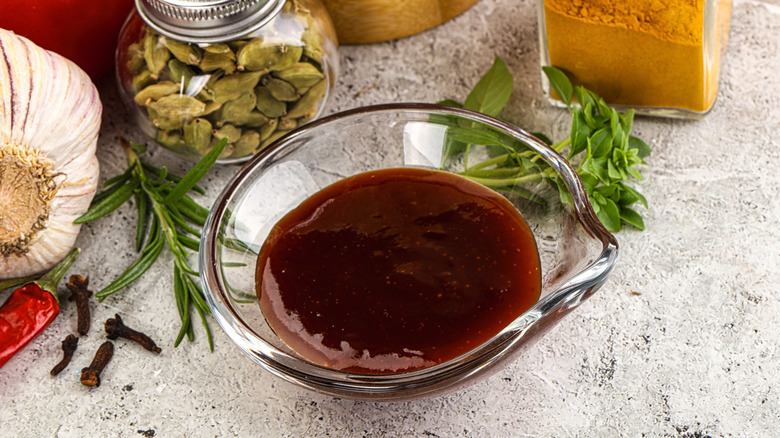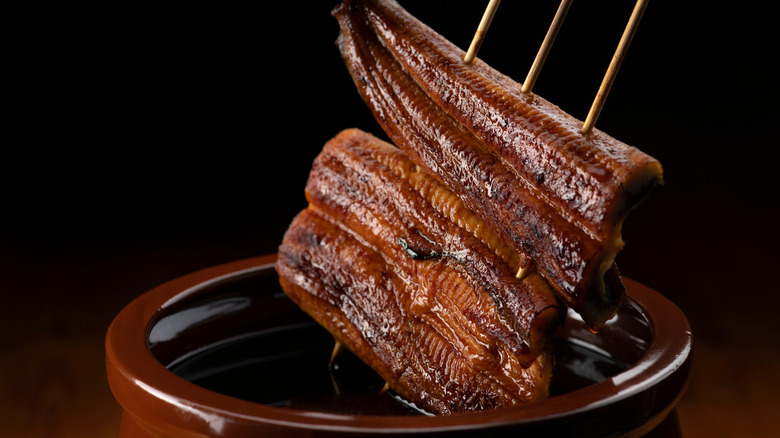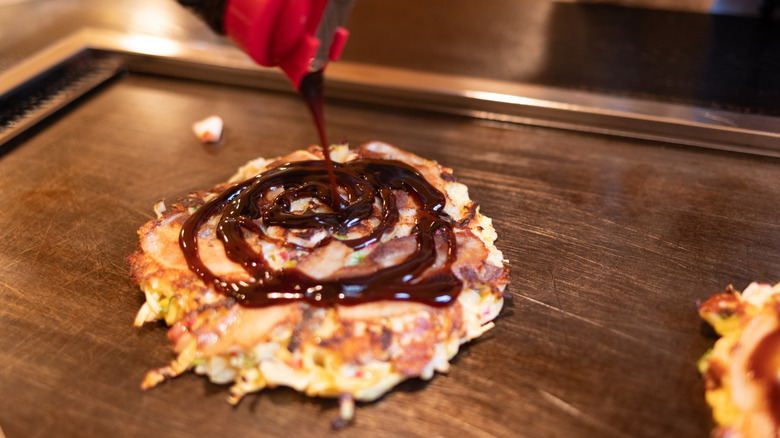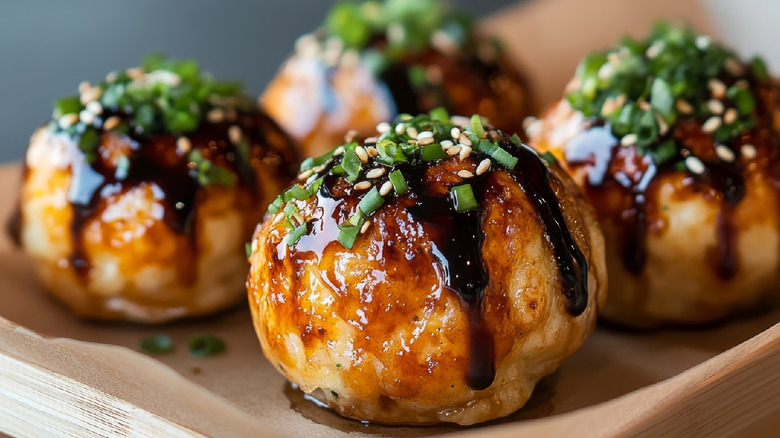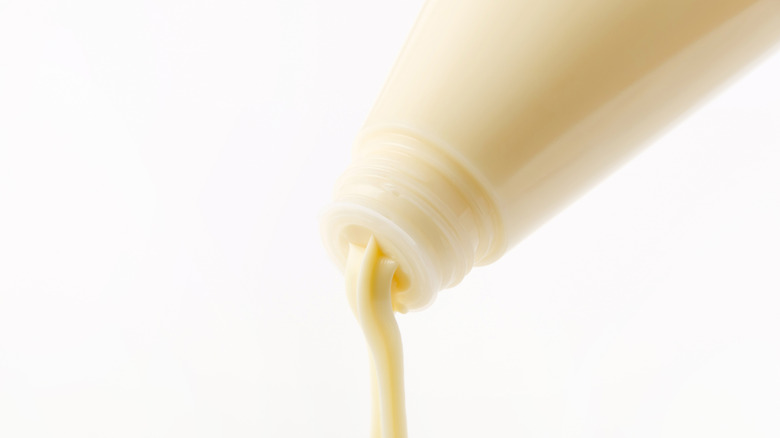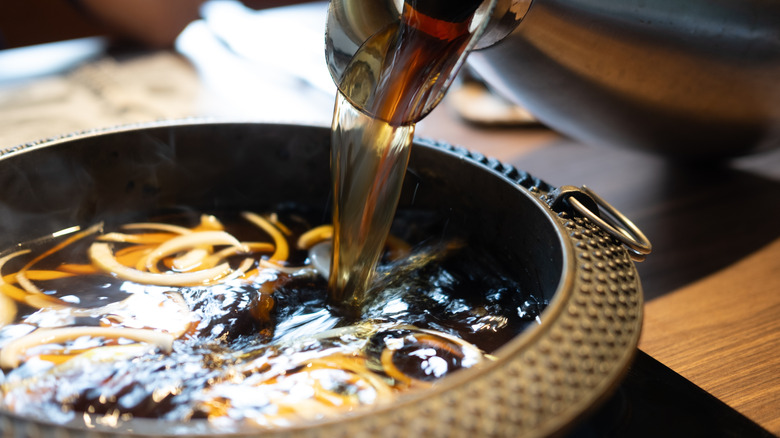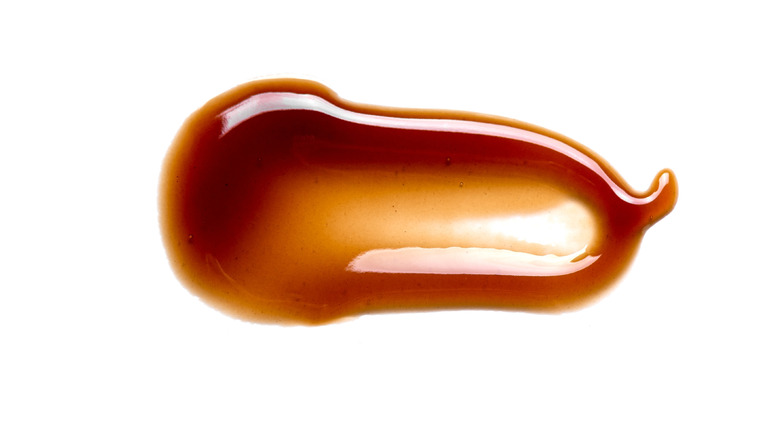12 Traditional Sauces You'll Find In Japan
Growing up in a Japanese-American household, we always had certain staple sauces in our pantry. I would constantly watch endless bottles of soy sauce and rice vinegar slowly become empty until they were immediately replaced. A similar scenario happened when I was the lead chef at a Japanese eatery in Southern California — bottles and bottles of these quintessential Japanese sauces were used to create hundreds of menu items. The clinking of empty glass bottles being tossed in the trash and replaced within seconds is a sound that still defines my life in the kitchen.
There is perhaps no feeling as heart-wrenching to a chef as reaching for one of these ingredients and being greeted by a drained bottle with little more than a tablespoon left inside. So, if there's a list of Japanese staples you want to make sure to have a surplus of, this list is the first place you want to look.
All of these sauces — alongside rice vinegar, mirin, miso, and sesame oil — lend themselves to countless traditional Japanese dishes. If you've got all these in your pantry, you have the mixing blocks for creating a wide array of sauces. Here's how to use these foundational ingredients to create 12 traditional sauces you'll find in Japan.
Shoyu
Shoyu is the Japanese word for soy sauce. There are numerous types of soy sauce on the market, ranging from Chinese and Korean to Vietnamese, each with different flavor profiles; however, Japanese-style shoyu is exceptionally unique. Shoyu distinguishes itself from other soy sauces due to its ratio of soybeans. For example, Chinese-style soy sauce is made from 100 percent soybeans, while shoyu is made from a blend of soybeans and wheat. This combination gives shoyu its umami-rich flavor, hint of sweetness, and subtle acidity.
Within the category of shoyu, you can find varieties with different colorings and consistencies. The most common type of shoyu sold in Japan is koikuchi, known for its dark color, deep savory flavor, and mellow sweetness. Koikuchi is typically used for both cooking and as a dipping sauce, adding its deep, dark brown color to dishes. The light version, usukuchi, is recognized for its pale color; however, don't let this lighter hue deceive you, as it is saltier than koikuchi. Usukuchi is excellent in dishes where you want to preserve the color of the ingredients while providing that quintessential salty flavor. Another popular type of shoyu is tamari, known for its thick consistency and unique savoriness and fragrance compared to other types of soy sauce. Tamari is perfect for dipping gyoza or using as a sauce for grilled meats.
Ponzu
Continuing with the topic of soy sauce, let me introduce you to ponzu, its citrus-flavored cousin. Ponzu is made from a combination of soy sauce, citrus juice (often lemon, orange, or yuzu), bonito flakes, kombu, and rice vinegar. It has a tangy and tart flavor with a thin, water-like consistency and a light brown color. The citrus juices set it apart from other Japanese sauces. Ponzu offers a great balance of salty, sour, and sweet, with a boost of umami from the soy sauce and bonito flakes.
Ponzu is most commonly served as a condiment alongside traditional Japanese dishes such as sashimi, shabu-shabu (hot pot), gyoza, and tempura. Its bright, citrusy flavor especially shines through with Japanese-style steak like tataki. There's no better combination than perfectly seared steak tataki dipped in a citrusy ponzu sauce.
Ponzu sauce has a rather peculiar history. The sauce was created in Dejima, Nagasaki, during the Edo Period. Its namesake is rooted in the Dutch-Japanese trade relations when the Japanese opened the artificial island of Deshima in the Port of Nagasaki to Dutch traders in the 17th century. It is believed the name ponzu means "vinegar punch," evolving from the Dutch word for "pon" for punch and "su" for vinegar, thus creating the name ponzu.
Tare
If you've ever had ramen or yakitori, you've probably had tare. The multi-purpose sauce is one of the most crucial components of these dishes, bringing an immense amount of salty, umami flavor. This tasty sauce is traditionally made by heating together soy sauce, sake, mirin, and a sweetener (usually fruit or sugar). Tare is slow-simmered for hours until it reaches its quintessential thick consistency and sweet flavor.
Tare is commonly used in yakitori bars, which are Japanese restaurants that specialize in chicken skewers grilled over charcoal flames. At a yakitori bar, grilled chicken skewers are continually glazed with tare while they're cooking. Yakitori and tare are synonymous — anytime you dine at a yakitori restaurant, chances are you'll spot a pot bubbling with tare sauce on the back burner. Alongside yakitori, tare is also used in ramen-making. A small ladle of the sauce is always added before the boiling broth and acts as a seasoning element for the bowl. The tare gives the ramen broth salty, umami, and acidic flavors that are so notable in the dish.
One of the greatest qualities about tare sauce is that you can use it on just about everything you're cooking. Whether it be smothering it over a grilled fish, using it to baste a pork shoulder, or drizzling it over a bowl of white rice, the versatility of the sauce is unbeatable. If you want to try making it at home, Tasting Table has got you covered with this delectable Tare Sauce recipe.
Mentsuyu
Does your chicken noodle soup need a little umami kick? If so, add a squirt of mentsuyu, the concentrated soup base that packs a ton of flavor. Mentsuyu, also known as tsuyu, is primarily used as a dipping sauce or broth for noodle dishes — the word mentetsuyu in Japanese translates to "noodle soup" in English. It can also be used as a dipping sauce for fried items like tempura and karaage. This versatile sauce is made by boiling down bonito broth, soy sauce, mirin, sake, and kombu, resulting in an undeniably rich umami flavor.
In most noodle dishes like udon, the mentsuyu is typically diluted with water to create a hot broth. In this instance, it's called "kaketsuyu." If it's used to dip noodles in as a condiment, it's referred to as "tsuketsuyu," which is typically served cold. One dish commonly served in the tsuketsuyu style is zaru soba, which features chilled buckwheat noodles served alongside a dish of tsuketsuyu sauce.
Besides being a soup base, mentsuyu is a great way to add additional flavor to your soups, broths, stews, and stir-fries. The sauce packs a fishy, umami flavor that can elevate any dish you're crafting. So the next time you're shopping at a Japanese grocery store, pick up a bottle of mentsuyu to add to your pantry.
Goma
Goma sauce, also known as goma dare, is a quintessential Japanese sauce made from toasted sesame seeds, rice wine vinegar, sugar, soy sauce, and sesame oil. The toasted sesame seeds are ground into a thick paste called "neri goma," and alongside the sesame oil, they provide the sauce with a deep, fatty, nutty flavor. That rich flavor is balanced by the acidity from the rice wine vinegar, sweetness from the sugar, and saltiness from the soy sauce. You can also find the sauce flavored with additional ingredients such as dashi powder, black pepper, miso paste, or ginger.
The sauce is typically used as a dipping sauce for the Japanese hot pot dish shabu-shabu. You're immediately served a side dish of goma sauce and ponzu to dunk the meat and vegetables in whenever you're eating at a shabu-shabu restaurant. The nutty, sesame sauce pairs perfectly with gently simmered sliced meat. Nothing beats a thinly sliced piece of kurobuta pork belly dipped in the buttery goma sauce. It is also widely used as a salad dressing. Most of the time, when you're served a salad at a Japanese restaurant, chances are the dressing is goma sauce.
Tonkatsu sauce
Tonkatsu sauce is a tasty, sweet sauce for drizzling over tonkatsu, the delicious Japanese fried pork cutlet. Just like peanut butter and jelly, tonkatsu and its sauce are a perfect combination. The crispy, crunchy cutlet paired with the sweet and acidic sauce is a culinary marriage.
Tonkatsu sauce is typically made of ketchup, Worcestershire sauce, soy sauce, spices, sugar, and various vegetables like tomatoes, onions, and carrots. In some tonkatsu restaurants, the sauce also includes fruits like prunes, apples, or dates for additional sweetness. The sauce is slow-simmered for hours to create its thick consistency and dark coloring. You can recognize tonkatsu sauce by its sweet flavor and the tangy taste from the Worcestershire sauce. The sauce was invented as an offshoot of Worcestershire sauce during the Westernization of the Meiji period (1867-1911) to appeal to the Japanese palate.
While the sauce was designed to drizzle over tonkatsu, the possibilities don't end there. It's common in tonkatsu restaurants to find an array of fried croquettes called "korokke" in Japanese, filled with various vegetables such as sweet potato, carrots, and eggplant, as well as different chopped meats. These korokke are always served alongside a squeeze bottle of tonkatsu sauce to cut through the fried flavor.
Unagi sauce
Unagi sauce, also referred to as "eel sauce," is a sweet condiment that's used to glaze grilled eel, fish, and meat. Surprisingly, unagi sauce doesn't actually contain any eel or seafood — the sauce is made by boiling down soy sauce, mirin, sake, and sugar. After cooking, the sauce has a deep, dark brown color with a slightly syrupy, thick consistency.
The most common preparation of freshwater eel that uses unagi sauce is the dish "unagi no kabayaki." This dish features the kabayaki method, where the freshwater eel is deboned and split in half lengthwise. It is then cut into rectangular pieces, skewered, and marinated with unagi sauce. The eel is cooked over a charcoal grill with an open flame to achieve its classic burnt and crispy skin; however, if you're cooking this at home, it can be done in the oven. Throughout the cooking process, the eel is constantly basted in unagi sauce, resulting in a sweet and savory finish.
Besides using unagi sauce for grilled eel, it's also a common condiment used by sushi chefs to drizzle over maki sushi rolls for additional umami flavor. You can also dip it into fried tempura and tonkatsu, or drizzle it over this Crispy Miso-Braised Pork Belly Salad as a garnish.
Okonomiyaki sauce
Okonomiyaki sauce is used to drizzle over okonomiyaki, a delectable pan-fried cabbage pancake that's a popular street food item in Japan. Similar to tonkatsu sauce, it has a base of Worcestershire sauce, ketchup, sugar, and soy sauce, along with the addition of oyster sauce and date syrup. It is far sweeter and less salty due to the date syrup compared to tonkatsu sauce, however, it still has that deep acidic punch from the Worcestershire sauce.
Two different types of okonomiyaki are drizzled with this delicious sauce: the Hiroshima-style and Osaka-style.The key difference between the two lies in their ingredients and cooking preparation. The Hiroshima-style okonomiyaki starts with a thin, crepe-like batter, and the ingredients are layered on top, including noodles, sliced green cabbage, and pork belly. The most popular is the Osaka-style okonomiyaki. This version is the simplest out of the two since it only features sliced green cabbage and pork belly. Plus, the ingredients are mixed inside the batter rather than stacked, similar to this Crispy Kimchi Pancake Recipe.
Either way, they're both completely covered in okonomiyaki sauce, Japanese mayonnaise, and bonito flakes. The deeply sweet and perfectly sour sauce pairs excellently with the steamed cabbage and crispy pork belly.
Takoyaki sauce
If you've ever devoured a plate of the mouthwatering ball-shaped snack, takoyaki, you've probably tasted its scrumptious sauce too. For those who don't know, takoyaki is a Japanese dish made from a wheat batter typically filled with minced octopus, sliced green onions, and pickled ginger. It's sold and cooked in the streets of Osaka, Japan, using a specialized half-dome-shaped pan, giving them their adorable round shape. After cooking, the takoyaki are doused in a delicious, sticky, soy-based sauce known as takoyaki sauce!
The sauce is prepared similarly to tonkatsu sauce, utilizing the acidic flavor of Worcestershire sauce but with fewer ingredients. It only consists of a combination of ketchup, Worcestershire sauce, sugar, and mentsuyu. The mentsuyu imparts a rich fishy taste to the sauce, creating a perfect harmony of savory umami flavor with the minced octopus. If you don't have mentsuyu on hand, you can substitute oyster or fish sauce in a pinch. After being covered in takoyaki sauce, they're given a squirt of Japanese mayonnaise and garnished with bonito flakes.
Besides takoyaki, the sauce serves as a great dipping sauce for any fried dishes or can even be drizzled over a slice of pizza for a fishy, umami flavor boost!
Japanese mayonnaise
Of course, mayonnaise isn't Japanese; however, just like many things in the world, they've made it so much better. Japanese mayonnaise differs from regular mayonnaise for various reasons. One being the Japanese version only utilizes egg yolks in the recipe, compared to regular mayonnaise, which uses whole eggs. As a result, the mayonnaise has a slightly pale yellow color with a much creamier and almost custard-like consistency. Japanese mayonnaise typically also includes MSG or monosodium glutamate, which gives it a delicious savory umami flavor.
The most well-known brand is Kewpie, which is easily recognizable from its squeezable bottle, bright red cap, and adorable mascot — some chefs even claim it's the best type of mayonnaise on the market. Japan's 7-Eleven egg salad sandwich fanatics will be delighted to know that Kewpie mayonnaise is the secret that gives it the irresistible umami flavor and creamy texture.
There are tons of ways you can use Japanese mayonnaise. Whether it be drizzling over your okonomoyaki pancake, making spicy mayonnaise for sushi, or spreading over a turkey sandwich, Japanese mayonnaise is definitely a game-changer. The savory, umami-bursting flavor and perfectly creamy texture have you ditching your typical store-bought brand of mayonnaise in no time.
Sukiyaki
Another delicious traditional soup base sauce you'll find in Japan is sukiyaki (also called warishita). Sukiyaki has a unique sweet and salty flavor profile. It's made from a combination of soy sauce, mirin, sake, sugar, and kombu broth; however, just like okonomiyaki, there are two different preparations based on region, the Kanto-style and Kansai-style.
Although sukiyaki is a type of soup-based sauce, it also refers to the dish made using the sauce. Both are cooked and served in a cast-iron pot at the dinner table. For Kanto-style, the sauce is prepared ahead of time by boiling together soy sauce, mirin, sake, kombu broth, and sugar — then the beef and vegetables are simmered together in the sauce. In Kansai-style sukiyaki, the beef is first slightly cooked in the pot, during which sugar is sprinkled on it. After the sugar has slightly caramelized, the vegetables are added and cooked in soy sauce and sake. Since there isn't any kombu broth added to the Kansai-style, it results in a relatively dry, saltier, and highly concentrated sauce. Both options are delicious and perfectly showcase the sweet flavor of the sauce.
There are plenty of other ways to use sukiyaki sauce besides making hot pot. Sukiyaki sauce is a great foundation to enhance any dish you're cooking. Don't be afraid to experiment! The sauce would be excellent as a marinade for grilled meat or seafood. It could also be used as a sauce for stir-fries or as a dipping sauce for tempura or dumplings.
Teriyaki sauce
Teriyaki is probably one of Japan's most recognizable sauces. In Japanese, teriyaki refers to the cooking method and dish that comprises two words: "teri," meaning "shine" or "luster," and "yaki," meaning grilled. The word specifically describes the preparation of grilling meat — typically beef, pork, fish, or crustaceans — that has been marinated and glazed in a sweet and salty sauce.
Over the years, teriyaki sauce has dominated Japanese-American restaurants, particularly in the Pacific Northwest, where the sauce has taken a new direction, becoming significantly sweeter. In the United States, teriyaki sauce often contains pineapple juice or honey as a sweetening agent rather than the typical granulated sugar, plus some fresh ginger and garlic. It is typically used as a sauce or marinade for proteins like beef or chicken, and then served as an additional sauce on the side. The American version has a thick, glossy, and sticky consistency with a dark brown color.
In Japan, the sauce is relatively simple. Traditionally, it combines soy sauce, sugar, mirin, and sake, resulting in a rich, salty umami taste with only a slight sweetness. It has a relatively thin consistency and lacks the syrupy viscosity compared to the American version.
